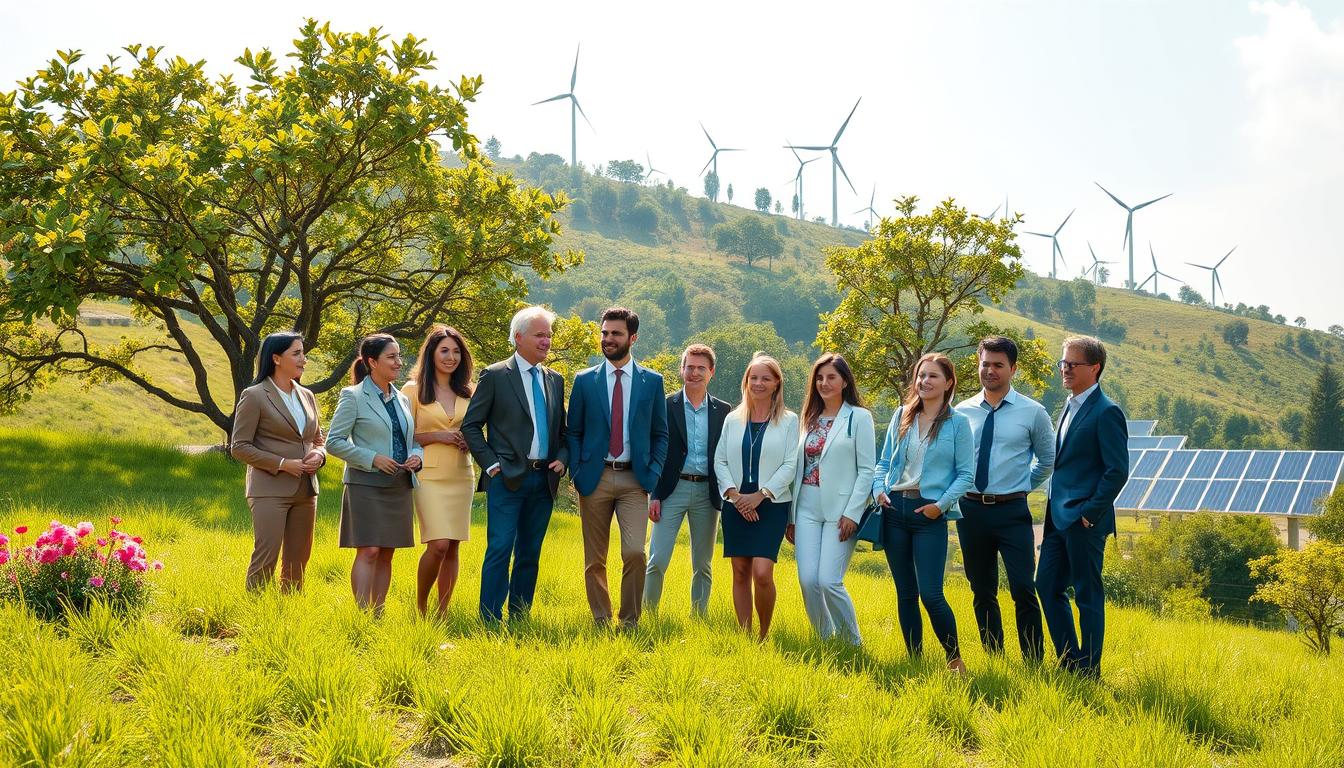The business world is changing fast, and the need for eco-conscious leaders is growing. Companies must now make money and care for the environment. Eco-conscious leadership is not just a trend; it’s a duty for businesses to protect the planet and their profits.
This article will explore the core of eco-conscious leadership. It shows how it can lead to real sustainability and growth. With a 130% increase in Google searches for sustainable products and services from 2017 to 2022, its importance is clear.
Key Takeaways
- Eco-conscious leadership is a crucial responsibility for forward-thinking businesses in the modern business landscape.
- Sustainable practices can drive cost savings, competitive edge, and increased economic practicality for organizations.
- Visionary leaders are essential in driving sustainability initiatives and setting clear, measurable goals.
- Overcoming resistance to change and navigating complex regulatory landscapes are among the key challenges faced by sustainable leaders.
- Integrating sustainability into corporate culture can enhance employee engagement and retention.
Understanding the Concept of Eco-conscious Leadership
Eco-conscious leadership is a big change in how leaders see their jobs. It means they think about the planet when making big decisions. They look at how their actions affect the environment, not just money.
Environmental Mindset: A Paradigm Shift In Leadership
Leaders who care about the environment know their choices shape their company’s future. They choose renewable energy, cut down on waste, and buy materials that are good for the planet. Even if it costs more upfront, they see the long-term benefits.
These leaders take a big-picture view. They work together with others to make a bigger difference. By teaming up with suppliers and communities, they help change the system for the better.
“Eco-conscious leadership involves making strategic decisions that consider the environmental impact of every action a company takes.” – CXO 2.0 Conference
Using eco-friendly strategies is crucial for leaders today. Companies that focus on the environment can meet growing demand for green products. They also save money and improve their image.
The Growing Importance of Sustainability in Consumer Behavior

More people want to live in ways that are better for the planet. This has led to a big change in how we shop. Now, many of us choose products that are good for the environment.
Consumer Statistics About Sustainability
Studies show that almost two-thirds of Americans worry about global warming. There’s been a huge jump in searches for eco-friendly products online. In 2021, 93% of people said the pandemic made them think more about being green.
Also, over 60% of people in a 2020 survey said they’d pay extra for items with green packaging. This shows how important sustainability is becoming.
What Companies Are Doing to Become More Sustainable
Companies are changing how they do business to meet these new needs. They’re focusing on sustainable products, sustainable packaging, and being open about their practices. Here are some examples:
- The EU Deforestation Regulation (EUDR) makes companies prove their products don’t harm forests. If they don’t, they could face big fines.
- SAP is working on tools like Green Token to help businesses be more eco-friendly. They want to make it easier to track and reduce waste.
- Companies are setting big goals to cut down on pollution and waste. They want to make sure their products are better for the planet.
As more people care about the environment, companies are changing. They’re working hard to meet the needs of those who want to shop sustainably.
Eco-conscious Leadership: Implementing Sustainable Strategies

Turning eco-conscious ideas into real actions is crucial for effective leadership. Leaders who think creatively help their teams make products that are good for both customers and the planet. This approach is at the core of sustainable growth.
Sustainable Innovation: Pioneering for a Greener Future
Companies that focus on sustainability stand out and set new standards. Sustainable leadership means finding ways to make money and help society while protecting the environment. It’s about changing old ways of doing business to focus on people, planet, and profit.
Dealing with sustainability issues can actually help a company grow. For example, Patagonia grew a lot under Rose Marcario’s leadership. They did this by using sustainable materials, improving their supply chain, and giving to environmental causes.
Energy Efficiency: Powering Operations Responsibly
Eco-conscious leaders also focus on using less energy. They use new technologies and switch to renewable energy. This not only helps the environment but also saves money in the long run. Companies like FIFCO have even become water-positive, carbon-positive, and zero waste.
These leaders also support the circular economy. This means keeping products and materials in use for as long as possible, reducing waste. It’s part of a bigger plan for sustainable innovation and energy efficiency.
“Sustainable leadership demands a dedicated focus on innovation, challenging traditional business operations to create economic, social, and environmental value.”
Measuring and Communicating Eco-conscious Efforts

It’s important for leaders to measure the impact of their green initiatives. They set goals like cutting carbon emissions and using more renewable energy. By tracking these goals, they stay on track and improve over time.
Key Performance Indicators (KPIs): Metrics For Success
Eco-conscious leaders use KPIs to see how well their green efforts are doing. These might include:
- Percentage reduction in carbon emissions
- Water saved (in gallons or liters)
- Waste diverted from landfills (in tons or kilograms)
- Percentage of renewable energy used in operations
- Number of eco-friendly products or services introduced
- Employee engagement in sustainability initiatives
Transparent Reporting: Building Credibility And Trust
Companies should share their green progress in clear reports. This builds trust with customers, investors, and the community. By being open about their efforts, they show they care about the planet.
| Sustainability Metric | 2021 Performance | 2022 Target |
|---|---|---|
| Carbon Emissions Reduction | 12% | 20% |
| Water Saved | 4.2 million gallons | 6 million gallons |
| Waste Diverted from Landfills | 65% | 75% |
| Renewable Energy Usage | 25% | 35% |
By sharing their green goals and progress, leaders show they’re serious about the environment. This builds trust with everyone involved.
Fostering an Eco-conscious Organizational Culture
Eco-conscious leadership is more than just a few leaders at the top. It’s about making the whole organization care about the environment. Leaders empower everyone to help by teaching, encouraging new ideas, and celebrating successes.
Employee Empowerment: From The Bottom Up
Teaching employees about green practices helps them make better choices. This boosts employee empowerment and makes everyone feel responsible for the environment.
Leaders also want to hear new ideas for being green from everyone. Inclusion and diversity are key because different people bring different ideas. This leads to better and more creative ways to be green.
Recognizing and rewarding green actions is important. It shows that being green is valued and encourages others to do the same. This creates a cycle where everyone feels appreciated and wants to keep helping.
Creating an eco-conscious organizational culture lets everyone work together towards a greener future. It’s a powerful way to make lasting change.
| Company | Sustainable Practices | Impact |
|---|---|---|
| Patagonia | Transparent supply chain, waste reduction | Increased brand value and customer loyalty |
| IKEA | Use of renewable materials, energy-efficient practices | Reduced environmental impact and positive industry example |
| Investment in renewable energy, eco-friendly campuses | Reduced carbon footprint and carbon-neutral operations | |
| Interface Inc. | Circular economy model, innovative design strategies | Achieved carbon-neutral goal ahead of schedule |
“By empowering our employees to be sustainability champions, we’ve seen a remarkable surge in innovative ideas and a renewed sense of purpose across the organization.”
– Sarah Johnson, Chief Sustainability Officer, XYZ Corporation
Eco-conscious Leadership in the Business Landscape

The rise of eco-conscious leadership is changing the business world. Companies now see the value in being green. This shift helps the planet and opens doors for growth and innovation.
Consumer behavior shows how important sustainability is. Studies say 64% of people worldwide want brands to stand up for the environment. Also, 70% of businesses see better reputation and loyalty after going green. This demand pushes companies to make sustainability a key part of their plans.
Leaders need to keep up with sustainability trends. Conferences and events offer insights and networking. They help leaders understand the changing business world and find ways to be more sustainable.
| Sustainability Trends in the Business Landscape | Potential Benefits |
|---|---|
|
|
By embracing eco-conscious leadership, companies can lead the way in sustainability. They can grow and thrive by focusing on the environment. This approach opens up new opportunities and helps create a better future for everyone.
“Sustainability is not just a buzzword, but a strategic imperative for businesses that want to thrive in the modern landscape. Eco-conscious leadership is the key to unlocking long-term growth and success.”
Also Read : What Career Opportunities Are Available After Completing An Online MBA In Sustainability?
Conclusion
Eco-conscious leadership is key for businesses aiming for long-term success. It involves understanding and applying sustainable strategies. This helps create a culture that values the environment and drives real change.
As the need to protect our planet grows, making sustainability a core part of business is crucial. This shift is vital for success in today’s world.
Companies that adopt eco-conscious leadership can make a positive impact on the environment. They also set themselves up for long-term success. By focusing on sustainable innovation and energy efficiency, they build trust with their customers.
Moreover, they meet the growing demand for eco-friendly products and services. Creating an eco-conscious culture within the organization empowers employees. It makes them more committed to protecting the environment.
The importance of eco-conscious leadership in addressing environmental issues cannot be overstated. It guides businesses towards a sustainable future. By embracing this approach, companies can drive real change and contribute to the global sustainability movement.
FAQs
Q: What is the concept of sustainable leadership?
A: The concept of sustainable leadership revolves around integrating sustainability into leadership practices, emphasizing the importance of environmental stewardship and social responsibility in decision-making processes.
Q: How can leaders incorporate sustainability into leadership?
A: Leaders can incorporate sustainability into leadership by prioritizing sustainability goals, developing sustainability strategies, and ensuring that sustainability is a core aspect of their leadership practices.
Q: Why is prioritizing sustainability essential for business leaders?
A: Prioritizing sustainability is essential for business leaders because it helps minimize environmental challenges, contributes to positive change, and demonstrates a commitment to sustainability that resonates with stakeholders.
Q: What are some effective sustainable practices for business leaders?
A: Effective sustainable practices include reducing energy consumption, implementing recycling programs, and adopting eco-friendly practices that support environmental sustainability and benefit local communities.
Q: How do eco-conscious leaders recognize their role in sustainability efforts?
A: Eco-conscious leaders recognize their role in sustainability efforts by actively engaging in decision-making processes that prioritize environmental stewardship and contribute to sustainability initiatives within their organizations.
Q: What is the relationship between leadership practices and climate change?
A: Leadership practices play a crucial role in addressing climate change; leaders who embrace sustainability can develop strategies to mitigate environmental impacts and advocate for proactive measures against climate change.
Q: How can organizations ensure that sustainability is part of their culture?
A: Organizations can ensure that sustainability is part of their culture by embedding sustainability practices into their core values, providing training on sustainable leadership, and encouraging employees to engage in eco-friendly practices.
Q: What challenges do leaders face when incorporating sustainability into their leadership?
A: Leaders may face challenges such as resistance to change, limited resources for sustainability initiatives, and the need to balance short-term profits with long-term sustainability goals.
Q: What is the role of stakeholders in supporting sustainable leadership?
A: Stakeholders play a vital role in supporting sustainable leadership by holding leaders accountable for their sustainability commitments, advocating for responsible practices, and collaborating on sustainability efforts that benefit both the organization and the environment.
Q: How can leaders measure their commitment to sustainability?
A: Leaders can measure their commitment to sustainability by setting clear sustainability goals, tracking progress through key performance indicators, and regularly reporting on their sustainability efforts and achievements to stakeholders.
Q: What is the concept of sustainable leadership?
A: The concept of sustainable leadership refers to leadership practices that prioritize sustainability goals and integrate sustainability into decision-making processes. It emphasizes the importance of environmental stewardship and social responsibility, ensuring that leaders contribute positively to their local communities and the planet.
Q: How can leaders effectively incorporate sustainability into leadership?
A: Leaders can effectively incorporate sustainability into leadership by developing a commitment to sustainability and integrating sustainable practices into their business strategies. This includes prioritizing sustainability in decision-making, establishing sustainability goals, and leading by example in eco-friendly practices.
Q: What are some essential aspects of eco-conscious leadership?
A: Essential aspects of eco-conscious leadership include a commitment to environmental sustainability, the ability to minimize environmental challenges, and the incorporation of sustainable practices into everyday operations. Eco-conscious leaders also prioritize collaboration with stakeholders to promote positive change.
Q: How can businesses prioritize sustainability in their operations?
A: Businesses can prioritize sustainability by setting clear sustainability goals, implementing eco-friendly practices, and regularly assessing their environmental impact. This can involve reducing energy consumption, enhancing recycling efforts, and adopting sustainable business practices that benefit both the environment and local communities.
Q: What role do stakeholders play in sustainable leadership?
A: Stakeholders play a crucial role in sustainable leadership by influencing decision-making processes and supporting sustainability efforts. Effective eco-conscious leaders recognize the importance of engaging stakeholders to develop comprehensive sustainability strategies and ensure that sustainability is integrated throughout the organization.
Q: How can leadership practices contribute to climate change mitigation?
A: Leadership practices can contribute to climate change mitigation by promoting environmental stewardship and encouraging the adoption of sustainable practices within organizations. Leaders who embrace sustainability help reduce carbon footprints and foster a culture of responsibility that addresses climate change challenges.
Q: What are some common sustainable practices that leaders can adopt?
A: Common sustainable practices that leaders can adopt include implementing recycling programs, reducing energy consumption, sourcing materials responsibly, and investing in renewable energy. These practices not only minimize environmental impact but also demonstrate a commitment to sustainability.
Q: How can eco-conscious leaders drive positive change in their organizations?
A: Eco-conscious leaders can drive positive change by establishing a vision for sustainability, engaging employees in sustainability efforts, and recognizing the impact of their leadership on environmental and social outcomes. By leading in sustainability, they inspire others to contribute to a more sustainable future.
Q: Why is a commitment to environmental sustainability important for leaders?
A: A commitment to environmental sustainability is important for leaders because it sets the tone for organizational culture and values. Leaders who prioritize sustainability not only enhance their reputation but also play a vital role in addressing global environmental challenges, ensuring long-term viability for their organizations and communities.
Source Links
- https://www.linkedin.com/pulse/great-green-shift-how-eco-conscious-marketing-winning-hearts
- https://www.bright-path.org/leading-the-way-the-intersection-of-leadership-and-sustainability/
- https://www.cxo2conf.com/blog/eco-conscious-leadership-leading-your-company-toward-legitimate-sustainability-and-growth


